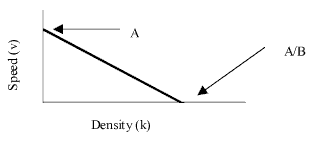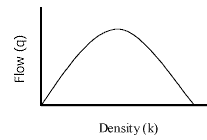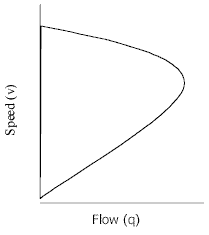
Greenshield’s Model
Greenshield was able to develop a model of uninterrupted traffic flow that predicts and
explains the trends that are observed in real traffic flows. While Greenshield’s
model is not perfect, it is fairly accurate and relatively simple.
Greenshield made the assumption that, under uninterrupted flow conditions, speed and
density are linearly related. This relationship is expressed mathematically and
graphically below. See figure 1.0.
v=A-B*k
Where:
v = speed (miles/hour, kilometers/hour)
A,B = constants determined from field observations
k = density (vehicles/mile, vehicles/kilometer)
As noted above, you can determine the values of the constants A and B through field
observations. This is normally done by collecting velocity and density data in the field,
plotting the data, and then using linear regression to fit a line through the data points.
The constant A represents the free flow speed, while A/B represents the jam density.
Figure 1.0: Speed vs. Density

Inserting Greenshield’s speed-density relationship into the general
speed-flow-density relationship yields the following equations:
q = (A-B*k)*k or q = A*k – B*k2
Where:
q = flow (vehicles/hour)
A,B = constants
k = density (vehicles/mile, vehicles/kilometer)
Figure 2.0: Flow vs. Density

This new relationship between flow and density provides an avenue for finding the
density at which the flow is maximized.
dq/dk = A – 2*B*k
setting dq/dK = 0 yields:
k = A/(2*B)
Therefore, at the density given above, the flow will be maximized. Substituting this
maximized value of k into the original speed-density relationship yields the speed at
which the flow is maximized.
v = A – B*(A/(2*B)) or v = A/2
This indicates that the maximum flow occurs when traffic is flowing at half of
free-flow speed (A). Substituting the optimum speed and density into the
speed-flow-density relationship yields the maximum flow.
q = (A/2)*(A/(2*B)) or q = A2/(4*B)
Figure 3.0 shows the relationship between flow and speed graphically.
Figure 3.0: Flow vs. Speed

As you can see, Greenshield’s model is quite powerful. The following can be
derived from Greenshield’s model:
- When the density is zero, the flow is zero because there are no vehicles on the roadway.
- As the density increases, the flow also increases to some maximum flow conditions.
- When the density reaches a maximum, generally called jam density, the flow must
be zero because the vehicles tend to line up end to end (parking lot conditions).
As the density increases the flow increases to some maximum value, but a continual
increase in density will cause the flow to decrease until jam density and zero flow
conditions are reached.
|